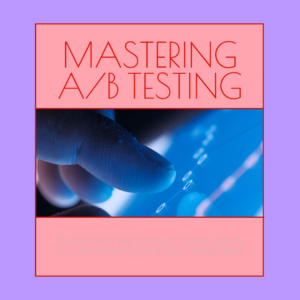Introduction:
In the ever-evolving landscape of digital marketing, the ability to optimize campaigns and maximize performance is paramount for success. A/B testing, also known as split testing, is a powerful technique that allows marketers to compare two or more versions of a marketing asset to determine which one performs better in achieving predefined goals. By leveraging A/B testing, marketers can make informed decisions, refine strategies, and drive continuous improvement in their digital marketing efforts. In this guide, we’ll explore the art of A/B testing and how it can be used to unlock the full potential of your digital marketing campaigns.

1. Setting Clear Objectives and Hypotheses:
Before conducting an A/B test, it’s essential to define clear objectives and hypotheses to guide your experimentation. Clearly outline the specific metrics and goals you aim to improve, such as click-through rates, conversion rates, or engagement metrics. Additionally, formulate hypotheses based on insights, data, or assumptions about what changes or variations may lead to better performance. By establishing clear objectives and hypotheses, you can focus your A/B testing efforts and measure success effectively.
2. Identifying Variables and Test Parameters:
In A/B testing, variables are the elements or factors that you modify or test between different versions of your marketing asset. These variables can include headlines, images, calls-to-action, ad copy, landing page layouts, or any other component that may influence user behavior. Identify the specific variables you want to test and define the parameters for each variation to ensure consistency and comparability between test groups. By carefully selecting variables and test parameters, you can isolate the impact of individual changes and draw meaningful conclusions from your test results.
3. Designing Controlled Experiments:
A/B testing involves conducting controlled experiments in which different versions of a marketing asset, known as variants, are randomly presented to distinct groups of users or audiences. To ensure the validity and reliability of your experiments, it’s crucial to control for external factors and variables that may confound the results. Randomly assign users to test groups, evenly distribute traffic or impressions between variants, and minimize external influences that could bias the outcomes. By designing controlled experiments, you can accurately assess the effectiveness of different variations and make data-driven decisions.
4. Implementing Testing Tools and Technologies:
To conduct A/B tests effectively, leverage testing tools and technologies that streamline the experimentation process and provide robust analytics and insights. There are various A/B testing platforms, software, and analytics tools available that offer features such as experiment setup, audience segmentation, statistical analysis, and reporting dashboards. Choose tools that align with your specific needs and objectives, and ensure they integrate seamlessly with your existing digital marketing ecosystem. By harnessing the power of testing tools and technologies, you can execute A/B tests efficiently and derive actionable insights to optimize your marketing campaigns.
5. Analyzing Results and Drawing Insights:
Once your A/B test is complete, analyze the results carefully to determine which variant performed better in achieving your predefined goals. Compare key performance metrics, such as conversion rates, click-through rates, or engagement metrics, between test groups to identify statistically significant differences. Look for patterns, trends, or insights that emerge from the data and draw conclusions about which changes or variations contributed to the observed outcomes. By analyzing results rigorously and drawing meaningful insights, you can refine your strategies, iterate on successful approaches, and continuously improve the performance of your digital marketing campaigns.
6. Iterating and Optimizing Continuously:
A/B testing is an iterative process that requires ongoing experimentation, iteration, and optimization to drive continuous improvement in your digital marketing efforts. Use the insights gained from A/B tests to inform future experiments, refine hypotheses, and iterate on successful variations. Continuously monitor performance metrics, track changes over time, and adapt your strategies based on evolving trends, audience preferences, and market dynamics. By embracing a culture of experimentation and optimization, you can stay ahead of the competition and maximize the impact of your digital marketing initiatives.
Conclusion:
A/B testing is a powerful tool that empowers marketers to make data-driven decisions, optimize campaigns, and achieve better results in their digital marketing efforts. By setting clear objectives and hypotheses, identifying variables and test parameters, designing controlled experiments, implementing testing tools and technologies, analyzing results rigorously, and iterating and optimizing continuously, marketers can unlock the full potential of A/B testing to drive continuous improvement and success in their digital marketing campaigns.
As you embark on your A/B testing journey, remember that experimentation is key to innovation and growth. Embrace uncertainty, test bold ideas, and be open to learning from both successes and failures. By harnessing the art of A/B testing, you can refine your strategies, delight your audience, and achieve transformative results in your digital marketing endeavors.



